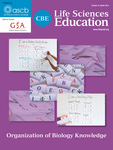Transdisciplinary Training between Physics and Biology Led to the Development of the Hydrodynamics Laws
Dear Editor:
I found the article from Breckler et al. (2013), titled “Using a Physics Experiment in a Lecture Setting to Engage Biology Students with the Concepts of Poiseuille's Law,” thought provoking. The authors’ aim was to test the effect of a new physics experiment on student learning of Poiseuille's law, and they found that watching a physics experiment as a lecture demonstration may be more useful to biology students with lower math ability (Breckler et al., 2013). This connection between physics and biology excited me, because I believe Poiseuille's law is one of the important symbols of the interplay between physics and biology, especially basic medical sciences. “Transdisciplinary” means beyond the disciplines, not starting within any particular discipline but with a problem or issue, and then bringing various disciplines to bear on solving the problem or addressing the issue (Meeth, 1978). During the 18th century and the first half of the 19th century, the transdisciplinary research of several physicians led to the proposals of the basic laws of hydrodynamics, such as Bernoulli's and Poiseuille's laws. I posit that three physicians (Bernoulli, Young, and Poiseuille) changed our understanding of the natural world, because of their distinctive educational experiences, which I describe below.
Daniel Bernoulli (1700–1782), who revolutionized our understanding of hydrodynamics, was a scientist whose family included three generations of accomplished physicists and mathematicians (Dietz and Heesterbeek, 2002). If we examine the life of the Bernoullis, we can see that scientific competition in the family and their unique training might have led to the development of important laws of hydrodynamics. Bernoulli's graduate thesis focused on respiratory mechanics and was the first application of calculus for solving a biological problem (Fye, 2001). He, along with the English physician William Harvey, conducted anatomical studies of blood movement with cadavers, providing the empirical evidence that demonstrates the physical law we call Bernoulli's principle (Guillen, 1995; Kardel, 1997).
Thomas Young (1773–1829) was the first scientist to examine the importance of elasticity of blood vessels (Hopkins, 1991), proposing the ratio between “stress” and “strain” as a coefficient called Young's module. Young was also trained as a physicist and a medical doctor (Oldham, 1974).
The last physician to contribute to our fundamental understanding of hydrodynamics was Jean Louis Marie Poiseuille (1799–1869). He was first trained in physics and mathematics, and, because of his great interest in blood flow, he was the first to use to the manometer to measure arterial pressure, which he did as part of his doctoral thesis (Hopkins, 1991). He was responsible for the use of “mm Hg” as the unit of measurement for blood pressure. Poiseuille found that minor changes in diameter can cause major changes in flow rates (Pfitzner, 1976). He observed a correlation between the viscosity of the fluid flowing in the pipes and the cylinder radius. The coefficient of viscosity for the CGS (centimeter-gram-second) unit system (dyne · s/cm2) was named “Poise” in his honor.
These historical examples illustrate that study of the biological and basic medical sciences led to the identification of physical laws. Today, the laws of physics may help to explain and visualize biological phenomena (Brewe et al., 2013). From an education perspective, I would propose that Poiseuille's law was the result of Poiseuille's transdisciplinary training, and now it has become the material of applied training, as demonstrated by Breckler and colleagues.
The boundaries between disciplines were not very sharply delineated in the periods when these three physician-physicists lived, thus facilitating transdisciplinary training. Today, the interaction between disciplines is limited. These three scientists began doing their transdisciplinary work in their late teens or early twenties (Oldham, 1974; Pfitzner, 1976; Hopkins, 1991; Guillen, 1995). As CBE—Life Sciences Education readers know, there are very few undergraduate courses in the discipline of biophysics (Kang and Purnell, 2011). Offering more undergraduate courses in the biophysical sciences, such as medical physics, biomechanics, cell biophysics, and biomedical engineering, may increase students’ interest in applied sciences. I hope that knowing more about the educational experiences of these three scientists prompts biology instructors to cross boundaries between disciplines and to offer more transdisciplinary undergraduate courses.



